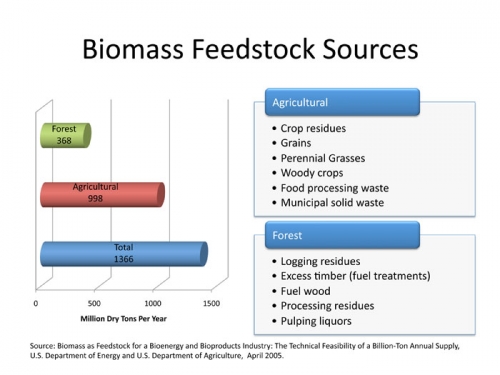A billion tons of biomass is available for bioenergy
US Departments of Agriculture and Energy conclude that we can sustainably harvest and remove a billion tons of biomass per year.
The U.S. Department of Energy (DOE) and the U.S. Department of Agriculture (USDA) commissioned a study to evaluate the potential volume of feedstock needed to meet the objectives of the Renewable Fuels Standard (RSA) set forth in the Energy Independence and Security Act (EISA). The study evaluated a variety of issues surrounding biomass feedstocks, including long-term soil carbon and productivity, soil erosion, accessibility, transportation costs, nutrient runoff and feasibility of collection and transportation. Figure 1 shows the relative distribution of feedstock by resource. Notice that the total resource potential is well above the goal at almost 1.4 billion tons.
Figure 1. Annual biomass resource potential from agricultural and forest resources. These resource potentials were divided into primary, secondary and tertiary categories according to volume and feasibility. Production of existing and new biomass feedstocks as well as improving yield will be an important part of achieving the Renewable Fuels Standard (RFS) goals. Equally important is collection of waste and byproducts from processing of forest and agricultural products.

The DOE and the USDA are both strongly committed to expanding the role of biomass as an energy source. In particular, they support biomass fuels and products as a way to reduce the need for oil and gas imports; support the growth of agriculture, forestry, and rural economies; and foster major new domestic industries in the form of bio-refineries that manufacture a variety of fuels, chemicals and other products.
Forestland and cropland resources have the potential to provide in excess of 1.3 billion dry tons annually — the equivalent of more than one-third the current demand for transportation fuels. More than 25 percent of this potential would come from extensively managed forestlands and about 75 percent from intensively managed croplands. The major primary resources would be logging residues and fuel treatments from forestland and crop residues and perennial crops from agricultural land.
For more information contact Dennis Pennington (pennin34@msu.edu) at 269-838-8265 or on the web at http://bioenergy.msu.edu.



 Print
Print Email
Email


